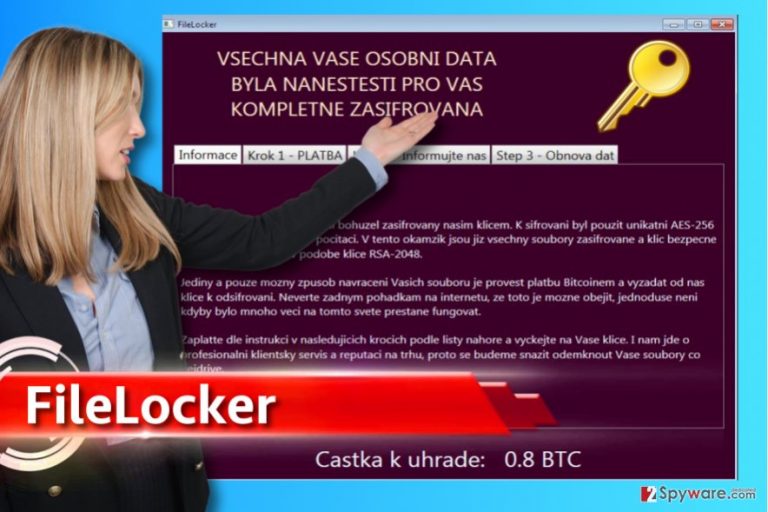FileLocker ransomware / virus (Virus Removal Guide) - Decryption Steps Included
FileLocker virus Removal Guide
What is FileLocker ransomware virus?
FileLocker virus is yet another crypto-ransomware that wants to collect ransoms
FileLocker virus is yet another ransomware[1] virus that some malware analysts identify as Czech-o-Slovak ransomware, Czech/Slovak ransomware or UserFilesLocker ransomware virus. However, we will call this ransomware virus FileLocker because it displays such name on the ransom note, which launches after UserFilesLocker.exe encrypts files on the compromised system. We want to point out that this ransomware targets media files only, and corrupts records that have these file extensions:
.avi, .mp4, .mkv, .div, .xvid, .webm, .flv, .ogv, .ogg, .mng, .mov, .qt, .wmv, . yuv, .rm, .rmvb, . asf, .mpeg, and .mpg.

The virus reportedly uses AES-256[2] and RSA-2048 ciphers to damage victim’s files. Each encrypted file also gets .ENCR file extension (added after the original one, so for example, video.flv will become video.flv.ENCR). As a result, the files with .ENCR file extensions can no longer be opened. The ransomware then launches a program window called FileLocker, which provides information in Czech language. It says: “Vsechna vase osobni data byla nanesti pro vas kompletne zasifrovana,” which means “All your files were completely encrypted.” The ransomware explains that without having the decryption key, the victim shouldn’t even dream about the data recovery. The virus asks to transmit 0.8 BTC (approximately 960 USD) to the ransomware authors and promises to provide data recovery tools then. Just like any other ransomware virus, it wants to receive the payment via Bitcoin payment system[3], so it leaves a Bitcoin wallet address. As always, we do not recommend trusting cyber criminals and paying them – we know a lot of cases when they simply deceived the victim and never provided the decryption tool even if the ransom was paid[4]. FileLocker ransomware even gives a lesson for the victim (rough translation): “professional customer service is what makes the reputation in the market, so better do something to unlock your files sooner.” We do not recommend you to follow this advice if you do not want to risk losing your money just like you lost your files. Instead, remove FileLocker ransomware virus with malware removal tools such as FortectIntego.
How did I get infected with this ransom-demanding virus?
Your files were encrypted by ransomware because you either visited a compromised website, opened a malicious email attachment or installed some kind of illegal programs (pirated ones). If you know how you got infected with ransomware, make sure not to repeat the same mistake in the future. However, it is not only careless browsing that can make you end up with ransomware on the system. Malicious viruses can sneak into your system using various technologies that help to exploit software vulnerabilities[5], or you can become a victim of a social engineering attack, too. There is no versatile way to protect yourself from ever-evolving ransomware, but if you layer up with protection measures, you should be fine. To start with, we suggest creating backups and installing anti-malware software. Do not forget to update the anti-malware software, as well as all other programs you have on your PC.
How to remove FileLocker ransomware?
If your files were compromised by FileLocker virus, do not try to improve the situation by deleting virus’ files manually. We suggest you prepare your computer for FileLocker removal by booting the system in a Safe Mode with Networking first. Once you do that, run or install anti-malware software and let it scan the system thoroughly. It might take a while, but be patient. Once it finishes the scan, delete all malicious files at once. Below, you will find a step-by-step FileLocker removal guide that explains everything in-detail.
Getting rid of FileLocker virus. Follow these steps
Manual removal using Safe Mode
Restart your PC according to these guidelines. It helps to deactivate the virus and prepare the computer for ransomware removal. In other words, it creates a safe environment for your anti-malware program to do its work properly.
Important! →
Manual removal guide might be too complicated for regular computer users. It requires advanced IT knowledge to be performed correctly (if vital system files are removed or damaged, it might result in full Windows compromise), and it also might take hours to complete. Therefore, we highly advise using the automatic method provided above instead.
Step 1. Access Safe Mode with Networking
Manual malware removal should be best performed in the Safe Mode environment.
Windows 7 / Vista / XP
- Click Start > Shutdown > Restart > OK.
- When your computer becomes active, start pressing F8 button (if that does not work, try F2, F12, Del, etc. – it all depends on your motherboard model) multiple times until you see the Advanced Boot Options window.
- Select Safe Mode with Networking from the list.

Windows 10 / Windows 8
- Right-click on Start button and select Settings.

- Scroll down to pick Update & Security.

- On the left side of the window, pick Recovery.
- Now scroll down to find Advanced Startup section.
- Click Restart now.

- Select Troubleshoot.

- Go to Advanced options.

- Select Startup Settings.

- Press Restart.
- Now press 5 or click 5) Enable Safe Mode with Networking.

Step 2. Shut down suspicious processes
Windows Task Manager is a useful tool that shows all the processes running in the background. If malware is running a process, you need to shut it down:
- Press Ctrl + Shift + Esc on your keyboard to open Windows Task Manager.
- Click on More details.

- Scroll down to Background processes section, and look for anything suspicious.
- Right-click and select Open file location.

- Go back to the process, right-click and pick End Task.

- Delete the contents of the malicious folder.
Step 3. Check program Startup
- Press Ctrl + Shift + Esc on your keyboard to open Windows Task Manager.
- Go to Startup tab.
- Right-click on the suspicious program and pick Disable.

Step 4. Delete virus files
Malware-related files can be found in various places within your computer. Here are instructions that could help you find them:
- Type in Disk Cleanup in Windows search and press Enter.

- Select the drive you want to clean (C: is your main drive by default and is likely to be the one that has malicious files in).
- Scroll through the Files to delete list and select the following:
Temporary Internet Files
Downloads
Recycle Bin
Temporary files - Pick Clean up system files.

- You can also look for other malicious files hidden in the following folders (type these entries in Windows Search and press Enter):
%AppData%
%LocalAppData%
%ProgramData%
%WinDir%
After you are finished, reboot the PC in normal mode.
Remove FileLocker using System Restore
-
Step 1: Reboot your computer to Safe Mode with Command Prompt
Windows 7 / Vista / XP- Click Start → Shutdown → Restart → OK.
- When your computer becomes active, start pressing F8 multiple times until you see the Advanced Boot Options window.
-
Select Command Prompt from the list

Windows 10 / Windows 8- Press the Power button at the Windows login screen. Now press and hold Shift, which is on your keyboard, and click Restart..
- Now select Troubleshoot → Advanced options → Startup Settings and finally press Restart.
-
Once your computer becomes active, select Enable Safe Mode with Command Prompt in Startup Settings window.

-
Step 2: Restore your system files and settings
-
Once the Command Prompt window shows up, enter cd restore and click Enter.

-
Now type rstrui.exe and press Enter again..

-
When a new window shows up, click Next and select your restore point that is prior the infiltration of FileLocker. After doing that, click Next.


-
Now click Yes to start system restore.

-
Once the Command Prompt window shows up, enter cd restore and click Enter.
Bonus: Recover your data
Guide which is presented above is supposed to help you remove FileLocker from your computer. To recover your encrypted files, we recommend using a detailed guide prepared by 2-spyware.com security experts.If you do not have a data backup, you can use any of these methods. We do not guarantee that they will help you to restore lost files, but it is still worth trying them.
If your files are encrypted by FileLocker, you can use several methods to restore them:
Recover data using special tool
Data Recovery Pro typically helps to restore various kinds of data, and we believe that it can help you in this situation, too. Here’s how you should use it:
- Download Data Recovery Pro;
- Follow the steps of Data Recovery Setup and install the program on your computer;
- Launch it and scan your computer for files encrypted by FileLocker ransomware;
- Restore them.
System Restore Point method
If you saved a system restore point in the past, this method will help you to bring your files back to life.
- Find an encrypted file you need to restore and right-click on it;
- Select “Properties” and go to “Previous versions” tab;
- Here, check each of available copies of the file in “Folder versions”. You should select the version you want to recover and click “Restore”.
Finally, you should always think about the protection of crypto-ransomwares. In order to protect your computer from FileLocker and other ransomwares, use a reputable anti-spyware, such as FortectIntego, SpyHunter 5Combo Cleaner or Malwarebytes
How to prevent from getting ransomware
Stream videos without limitations, no matter where you are
There are multiple parties that could find out almost anything about you by checking your online activity. While this is highly unlikely, advertisers and tech companies are constantly tracking you online. The first step to privacy should be a secure browser that focuses on tracker reduction to a minimum.
Even if you employ a secure browser, you will not be able to access websites that are restricted due to local government laws or other reasons. In other words, you may not be able to stream Disney+ or US-based Netflix in some countries. To bypass these restrictions, you can employ a powerful Private Internet Access VPN, which provides dedicated servers for torrenting and streaming, not slowing you down in the process.
Data backups are important – recover your lost files
Ransomware is one of the biggest threats to personal data. Once it is executed on a machine, it launches a sophisticated encryption algorithm that locks all your files, although it does not destroy them. The most common misconception is that anti-malware software can return files to their previous states. This is not true, however, and data remains locked after the malicious payload is deleted.
While regular data backups are the only secure method to recover your files after a ransomware attack, tools such as Data Recovery Pro can also be effective and restore at least some of your lost data.
- ^ Ransomware: Information and prevention. Sophos Community. Knowledge Base.
- ^ How safe is safe? AES 256 encryption and your data. Canadian Cloud Backup. Datacentres in Canada.
- ^ Dean Takahashi. Ransomware has exploded thanks to Bitcoin’s anonymity. VentureBeat. Tech News That Matters.
- ^ Aida Akl. Here’s Why You Shouldn’t Pay to Unlock Ransomware. VOA News. Voice of America Blogs.
- ^ Angler exploit kit rings in 2016 with CryptoWall ransomware. Naked Security. Computer security news, opinion, advice and research from anti-virus experts Sophos.







